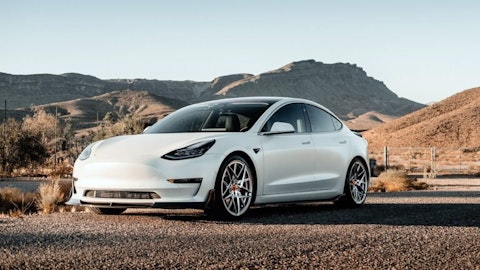Alexander Potter: Okay, perfect. Thanks. And then I wanted to go back to something Claire had mentioned regarding OpEx. It looks like second half OpEx spending is going to be down relative to the first half. Just wondering what it is that you’re spending on now or what you did spend on in the first half that you won’t be spending on in the second half. Is this marketing and outreach? You mentioned a lot with test drives and things of that nature after the R2 and R3 unveiling just or maybe it’s R&D just any additional clarity on that would be helpful. Thanks.
Claire Mcdonough: Sure. So the first point is in the first half of the year in the buildup to the tooling upgrades that we made in normal, there were higher levels of R&D spend associated with that. We’ll see that increase as well Q1 into Q2, based off of the shutdown time that we took throughout the course of April and the incremental contractors and support that we had to bring back the lines up in short order and succession. And so as we look to the second half of the year, as RJ mentioned, the pivot and focus from an R&D perspective starts to focus around more of the R2 development work versus the focus on both R2 as well as R1 and our commercial vans that you’re seeing in the first half results and figures. And then beyond that, we’re constantly driving incremental efficiency across the organization as a whole.
And so that entails finding ways in which we can reduce expense in other areas of SG&A to make room for the investments that we’re making in our go-to-market teams between sales and service as a whole. And so that, that intensity and focus is what’s enabling our path to reduce our operating expenses overall for the year, but also importantly, seeing that second half 2024 step change reduction in OpEx.
Alexander Potter: Excellent. Thanks guys.
Operator: Thank you. And our next question comes from Emmanuel Rosner with Deutsche Bank. Your line is open.
Emmanuel Rosner: Thank you very much. My first question is now that the set down is completed and the upgrades completed. Could you help us quantify some of the benefits that you’re expecting that are in your control? So they were always hoping to understand it better. So you had this $39,000 loss per vehicle in Q1, $9,000 of that maybe sort of like not a run rate, so call it maybe a $30,000 loss per vehicle starting point. How much is realistic for your cost of goods sold or bill of material to improve as a result of the actions that you just completed? How much per vehicle could we see in terms of reduction on the fixed cost? And how much do we have to assume or do you have to assume in terms of pricing or sort of like extra revenues essentially to get towards that positive gross profit per vehicle.
Claire Mcdonough: Yeah, sure. Emmanuel, as we look back at our Q4 earnings call, we provided a detailed bridge and we continue to see line of sight at the execution roadmap to achieve those results in aggregate. As I mentioned in one of my responses, the largest variable that we have ahead of ourselves is the reduction in our material costs. And similar to what we saw when we took downtime in Q1 of ’23 to introduce our new Enduro drive unit as well as our LFP pack in the EDV itself, where we saw a 35% reduction in material cost. There’s significant cost savings coming through the introduction of engineering design driven changes into the R1, as well as some of the material changes that we’re making to conserve costs as well.
So I have clear visibility into those reductions on a go forward basis. And similarly, as I mentioned, the improvements in operational efficiency that we’ll see with reductions in labor and overhead cost per unit, given the increase of 30% in our line rate is also going to help enable the semi fixed cost improvements that we anticipate throughout the course of this year as well. And then there’s dynamics with our depreciation and the fact that this quarter we had accelerated depreciation going into our retooling upgrade in the plant itself that will start to lap and will come off as we also begin to fully depreciate some of our original tooling that we’ll see a material decrease in that depreciation expense per unit as well. Beyond that, we’ll see some additional LCNRV benefits in the back half of the year as we drive towards making money on every single vehicle that we sell.
And then in terms of the underlying assumptions for both volume as well as price point, as we mentioned on our last earnings call, our anticipation is not a significant increase in overall volumes associated with Q4 ’24 relative to Q4 of 2023 and equally a similar price point from an ASP perspective. So the revenue per unit driver is really driven by non-vehicle revenue streams, predominantly with the sale of regulatory credits, we’ve seen a really robust appetite for our regulatory credits in the market, especially with many OEMs stepping back away from some of their electrification plans and then equally the ongoing sales of software and services revenues as well as our marketing revenue streams that will enable Rivian to achieve positive gross profit in the fourth quarter.
Emmanuel Rosner: Okay, that’s helpful. And then just one follow up on the volume side. I think you made a comment in the prepared remarks that now that the shutdown is completed. You have 56,000 units of annual capacity for R1 on two shifts. Is this sort of like the right volume to think about now on a go-forward basis for Rivian all the way until R2 launches in the first half of 2026, so essentially a maximum of 56,000 units of R1 minus any shutdown impact that you may have, let’s say, next year plus some level of growth in EVDs. But is that 56,000 essentially the max we’ll see in terms of annual R1 capacity and then it’s R2 that comes on top of it?
Claire Mcdonough: Yeah. Sure. So there’s a couple of points I want to make. First, as we think about the longer term introduction of R2 in normal, we’re building capacity towards 215,000 units in aggregate. And that can shift between our three vehicle lines where we’ll have 85,000 units of maximum capacity for R1, 65,000 units of capacity for commercial vans and 155,000 units of capacity for R2. So within that matrix, we’ll have the ability to flex volumes to stay within the balance of the 215,000 units of total maximum capacity. And so that could be achieved, for example, running two shifts on R1, full three shifts on R2 and a single shift on commercial vans. So there’s flexibility as we think about the longer term volumes, but it is accurate as you noted that the R1 volumes will be 56,000 units based off of the two shift operation.





